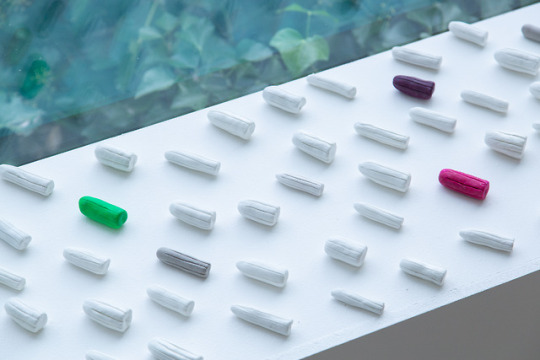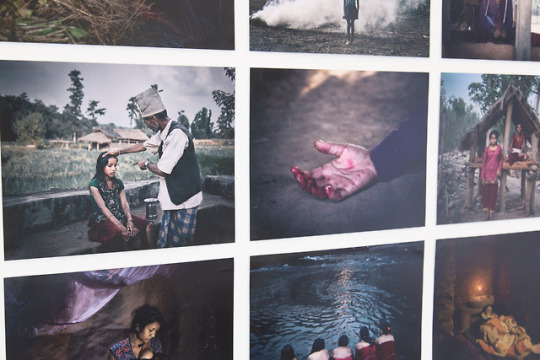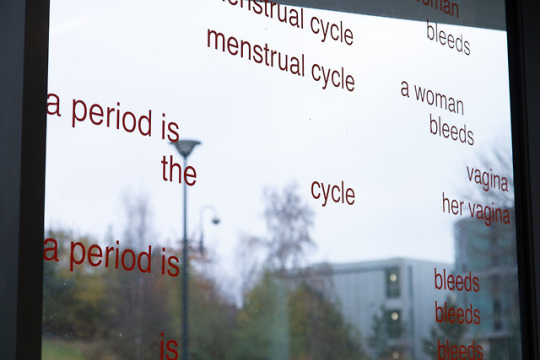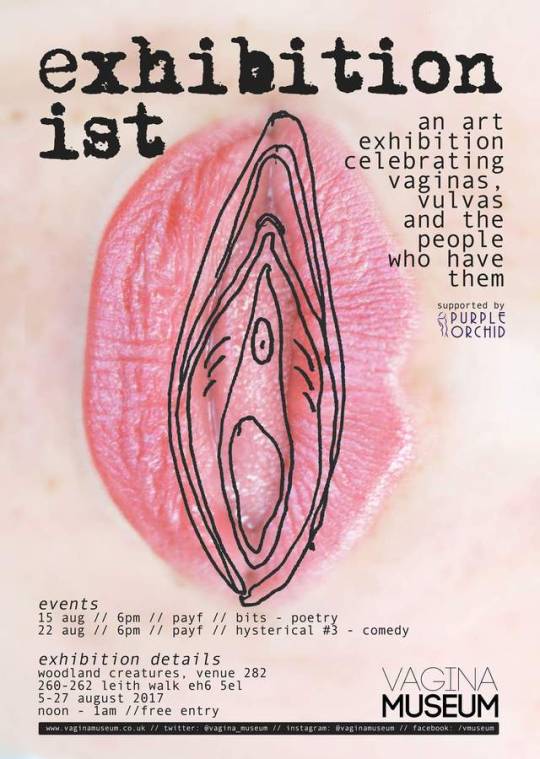Photo










A Selection of photographs taken during the installation of Periodical Exhibition, curated by Bee Hughes, 15 - 28 November 2018 at Atrium Gallery, Liverpool School of Art & Design.
All artworks are the intellectual property of the artist.
With thanks to LJMU Special Collections and Archives.
Photographs by Milos Simpraga, 15 November 2018.
#exhibition#art#menstruation#menstrual art#periodical#curating#body art#craft#photography#poetry#archives
22 notes
·
View notes
Text
Menstruation in Visual Culture
This short essay by Bee Hughes was published as part of Periodical Exhibition, curated by Bee Hughes as part of Being Human festival of the Humanities 2018.
The exhibition was held at Atrium Gallery, Liverpool School of Art & Design, 15 - 28 November 2018.
The last one hundred years has seen a rich and varied terrain of materials in the arts and broader visual culture relating to menstruation. The most prominent images of menstruation we have come from mainstream visual culture in the form of advertising, TV, and films. Adverts tend to present images that exploit deep-seated beliefs that menstruation is unclean and should be hidden from public view and discussion in order to sell the latest products that will keep you ‘fresh’ and ‘safe’ from dreaded leaks. From early-20th century, the language of advertising built around the newly available disposable menstrual products set the tone that has only very recently begun to shift.
As Jennifer Weiss-Wolf observes in her 2017 book on the campaign for menstrual equity in the United States, to sell menstrual products the message from companies ‘was always the same. No leaks, no stains. No pain. No problem’. The first advertising campaign for a disposable menstrual product to feature (fake) red blood instead of blue liquid was Bodyform’s ‘Blood Normal’ campaign video, released in 2017. It was seen as groundbreaking, but seems more a marketing strategy than a genuine representation of an ordinary bodily function. In her article ‘Blood in the Shower’ (2018) Camilla Mørk Røstvik argues artists and activists have built up alternative depictions and discussions of menstruation. While they challenge the commercialisation of menstruation, she notes that this work is often appropriated by commercial menstrual product companies.
Stephen King’s novel Carrie (1974) and its film adaptation(s) (1976, 2002, 2013) provide perhaps the most memorable depictions of menstruation in pop culture with the supernaturally-powered Carrie exacting fiery revenge on the classmates who bully her after the onset of her first period. The story is dripping with stereotypes about periods, from the idea that they are unclean to the exaggerated presentation of a menstruating woman with no control of her emotions. It’s safe to say that these everyday and pop depictions have dominated the formation of menstrual norms in our cultural consciousness.
Though perhaps less well-known in the public sphere, artists have been countering the secrecy and shame surrounding periods since at least the early 1970s. In 1970 in Denmark, a collective of feminist artists, Kannonclubben, created a series of tableau performances called Damebilleder (Images of Women) which culminated in a live-in installation where they created a living space filled with red furnishings, which then prompted discussions of their experiences of menstruation.
In the USA, Judy Chicago produced the now iconic photolithograph Red Flag (1971), a tightly framed image of the artist removing a bloody tampon from her vagina. In the same year, Leslie Labowitz-Starus performed her Menstruation Wait, in Los Angeles and Dusseldorf, sitting quietly on the floor waiting for her period to begin. There have been numerous visual and performance works where artists use both their own blood or fake blood defiantly presenting menstruation to their audiences in all their visceral and messy reality.
Whereas everyday representations in visual culture often present negative narratives of menstruation that should be kept under wraps, artists have countered the mainstream with unapologetic images of menstruators and their blood that are almost completely absent from advertising and popular culture. Art plays an important role in promoting a radical alternative view of menstruation, which reflects the bloody realities of menstruation and presents a range of experiences. It's important that space is created to show and share these responses to menstruation outside the polished, sanitised visual narratives of the menstrual product industry.
#menstruation#menstrual cycle#menstrual art#visual culture#short essay#exhibition text#curating#research
0 notes
Text
Periodical Exhibition
Periodical Exhibition
Curated by Bee Hughes
15th – 28th November 2018
Periodical is an exhibition of menstrual art, photography, and archival material exploring and challenging cultural ideas about periods in the UK and Nepal. We invite people of all ages and genders to come together to break the cycle of secrecy and misinformation that has contributed to the stigmatisation of menstruation, period poverty, and harmful practices and restrictions that impact the everyday lives of people who menstruate. Whether you are a menstrual maestro or curious about cycles, Periodical is a shame-free space to discuss menstruation for people who do and do not menstruate.
The Being Human Festival theme for 2018 - ‘Origins and Endings’ - is threaded throughout this exhibition. Menstruation is often seen as the beginning of life as an adult for adolescent girls with menarche (the first period in a menstruators life) considered a rite of passage. Equally, menopause - the ending of the menstrual cycle - is considered by many to be the beginning of a new phase of life. Periodical presents some of the origins of our cultural attitudes to menstruation shaped by medicine and media representations, and suggests ways to change prevailing negative associations through new representations and education, bringing periods fuss-free into our everyday conversations.
Join us to explore attitudes to menstruation in the late 20th century though our cabinets of specially selected items from the LJMU Femorabilia Archive of magazines for girls and women. Through thematically curated displays, we invite you to think about the similarities and differences in advertising messages from the 1960s to the 1990s and consider key ideas used to sell menstrual products. We round off our vitrine displays by contrasting the mainstream and commercial perspectives found in advertising materials with examples of educational publications and zines.
Artworks by Bee Hughes ask us to question stigma around menstruation and the menstruating body as both unclean and overly sexualised, and challenges the medicalised notion of a regular and regulated menstrual cycle that happens like clockwork for all people who menstruate. Bee’s visual works explore her own experience of menstruating, while her poetic works deconstruct the language of menstrual health advice, questioning the rigid use of gendered language that often conflates the ability to menstruate with womanhood. Her recently published analysis of UK health advice websites found their language reflects rigid and binary notions of gender, and present menstruation as a problem to be solved, but give little consideration to alternatives to commercial, disposable menstrual products.
Amanda Atkinson’s installation lays bare the financial cost of menstruating, underscoring the need for universal access to free menstrual products. The issue of period poverty and its relevance to wider social problems linked to the UK Government’s policies of economic austerity is highlighted by the work of the Homeless Period Liverpool to provide menstrual products to homeless people, school pupils and food bank users across Merseyside.
Poulomi Basu’s photographs investigate the causes and consequences of ritual violence against Nepali women through the practice of ‘chaupadi’ which exiles menstruating women from the home. The photos are not those of passive victims but of a courage in the face of extreme adversity. The women have come forward to share their stories and break menstrual taboos. The project is a form of dissent and protest. Poulomi has played a huge role in putting pressure on the Nepalese government to ban the practice of chaupadi, a practice finally made illegal in August 2017. Nonetheless, a huge amount of work remains: chaupadi is much more than an issue of law and order.
Sara Parker and Kay Standing’s installation reflects their British Academy funded collaborative research on menstruation in Nepal which focuses on the right to a dignified menstruation. Working with local partners across Nepal it explores artefacts and stories around menstruation they aim to develop in-depth understanding of nuances of religious, social and cultural beliefs underpinning menstrual stigmas and exclusionary practices, in order to challenge these at the local level.
Chella Quint’ is a dedicated campaigner and leading expert on menstrual education. She is an author, comedian, designer, writer and researcher who coined the term ‘period positive’. As founder of the #periodpositive campaign, Chella makes a huge contribution to dispelling stigma and opening up discussions about periods in the UK and around the world. Described as a ‘force of nature’ by Shami Chakrabarti, all aspects of Chella’s work is infused with careful research and her signature sense of humour.
Sasha Spyrou’s illustrations invite us into a world where everyday objects become uncanny characters. Her work has been described as having an enchanted quality, conjuring a fantastical world with colourful narratives and histories woven around characters. Sasha’s illustrations are deceptively lighthearted, fusing charm and uncanny nostalgia with a deeply thoughtful edge.
Thanks to Emma Ashman, Jennifer Lynch, Emily Parsons, Rebecca Smith, Milos Simpraga, Kay Standing, LJMU Special Collections and Archives, The Homeless Period Liverpool and all contributing artists.
This event is part of the national Being Human festival of the humanities, which will be taking place in around 50 towns and cities across the UK between 15-24 November.
Being Human is the only national festival dedicated entirely to celebrating research across the humanities – from archaeology, history, languages, philosophy and more. This year the festival explores the theme of ‘Origins and Endings’. Being Human aims to make the humanities accessible and fun for all, and is run by the School of Advanced Study, University of London in partnership with the Arts and Humanities Research Council and the British Academy.

#menstruation#Menstrual cycle#menstruation art#beinghuman18#curating#exhibition#research#humanities#practice led
1 note
·
View note
Photo

Cycles: Series 2 / Month 1 / Week 2
#gif#menstruation#menstrualcycle#body print#bodyart#printmaking#vulvae#periods#period positive#body positive
4 notes
·
View notes
Photo

Cycles: Series Two / Month One / Week One
2 notes
·
View notes
Photo

2 notes
·
View notes
Photo


Comfort Zones by Bee Hughes and Eva Petersen pop-up exhibition 26/10/17 - 3/11/17 Liverpool School of Art & Design
1 note
·
View note
Photo

Comfort Zones is an exhibition of works in progress by Bee Hughes and Eva Petersen which brings together pieces created as part of their individual PhD research with a new collaborative soundwork.
The works presented were developed from an interrogation of their own comfort zones regarding the representation of female bodies, and confront how different aspects of female identities are perceived and received. Through their visual works both artists aim to question the simultaneous objectification and censorship of female bodies and experiences in different areas of contemporary culture.
The soundwork – Un-voiced (2017) – embraces ambiguity, drawing on themes including identity and cultural performance and cultures of performance. The piece combines spoken word with non-vocal sounds, alluding to the various ways our contemporary culture tends to silence or homogenise individual female experiences.
Bee’s research explores menstruation and its associated rituals and behaviours – from people who have periods and do not - as a process which reinforces certain social performances of gender. Through the documentation of her own bodily cycles Bee aims to present menstruation as a constantly shifting process that fluctuates within everyday life, as opposed to the static and regimented pattern we often expect it to be. The daily ritual of making prints eventually becomes a long-term record, establishing a space of resistance to everyday cultural narratives of menstruation. The creation of this work has been embedded in Bee’s daily routines, forming an archival document of the changes in her body over an extended period of time. The ritual of making prints establishes a space of resistance to everyday cultural narratives which regard menstruation as a taboo subject, and as a ‘problem’ for individual women to deal with.
Eva’s research is a response to the restrictions she faced as a woman performing, writing and composing music within the music industry. Through her autobiographical work, she aims to reclaim creative autonomy by creating an album entitled Voices of Winter Palace of which she has total creative control - from the composition of the music, lyrics, melodies to artwork, video, studio recording, music production and performance. Eva’s compositions are created using graphic scores and non-traditional notation which she developed as an aide-memoir whilst on tour as a recording artist at the beginning of her music career. The graphic scores and notation have become a piece of visual artwork in their own right. Through her work, Eva questions the perceptions of a
woman’s body and her own comfort zones as a performer within the music industry. Eva’s three photographic prints Yes, I Am Looking Straight at You (2017) are a series of self-portraits taken before, during and after singing. The series is a response to the objectification of her performances, the stereotypical photography sessions she experienced as a musician and an exploration of the threat of leading women performers.
#exhibition#bodyart#soundart#collaboration#performance#identity#feministart#photography#self portrait#interdisciplinary
2 notes
·
View notes
Link
My work was recently selected to be shown as part of the annual Open Exhibition at Galeri in Caernarfon, North Wales. I will be showing this documentary photograph of the ongoing ‘Cycles’ series. This will be my first exhibition in back in North Wales, having left 9 years ago to start my degree, so it’s exciting for me to have been selected alongside other artists from North Wales and beyond. Though I’m showing documentation, not the original work, I’m looking forward to hopefully sparking some interesting discussions about the ideas and attitudes people have towards menstruation. The following texts in English and Welsh will accompany the piece:
In Cycles I use my body as a printing press to produce daily monoprints which highlight the menstrual cycle as a process in flux, as opposed to a clockwork and consistent pattern. The ritual of making prints becomes a long-term record of resistance to our everyday cultural narrative of periods.
Yn Cylchred ‘rwyf yn defnyddio fy nghorff fel peiriant argraffu i greu monoprint dyddiol. Mae’r argraffiadau yn amlygu’r misglwyf fel proses sy’n newid o hyd, yn hytrach na patrwm hollol gyson. Mae’r proses o argraffu yn cynrychioli gwrthwynebiad tuag at y syniadau cyfredol o’r gylchred fislifol yn ein diwylliant.
0 notes
Photo

I’ll be exhibiting my digital collage print ‘Incomplete Cycle (December)’ at this exhibition, hosted by the Vagina Museum as part of the Edinburgh Fringe Festival.
Poster image: Sophia Weisstub
The exhibition runs from August 5th - 27th at Woodland Creatures. Here’s the link to the Facebook event:
https://goo.gl/wq9Y89
59 notes
·
View notes
Photo

Studio installation / project mid-point -
Cycles (2016-2017)
Acrylic, menstrual blood and stitching on 6 (will be 12) linen scrolls.
Each scroll is 3 metres long, and the work can be installed in a number of configurations, fully or partially rolled up as either a wall or vitrine exhibit.
#bodyprint#bodyart#body positive#artist#artist on tumblr#vulva#vulva art#vagina#female#menstruation#menstrual cycle#period#period art#menstruation art#printmaking#experimental#drawing#monotype#monoprint#digital photo#documentation#performance#performativeprintmaking#humanbody#rhythms#cycles#ritual#process#scroll#fabric
6 notes
·
View notes
Photo

Incomplete Cycle 3 (November)
(2016)
digital collage of 25 monotype prints
from individual monotype bodyprints produced daily in acrylic and menstrual blood on hand stitched linen scroll over 29 days
#vulva#vagina#labia#vulvaart#vagina art#self portrait#nude#anatomy#drawing#printmaking#bodyprint#monotype#menstrualcycle#menstruation#period#periodsart#menstruationart#art#time#process#fabric#skin#digitalphotography#postdigital#daily#minipill#hormonal contraception#irregular menstruation#irregular periods#documentation
9 notes
·
View notes
Photo

Section: Month 4 (2016)
Each 'month' (loosely 28 days, not calendar months) is printed, day by day, onto white linen scrolls. There is no definite end-point for this project, but it will continue until are at least 12 scrolls, a whole year of prints. The project draws out the usually fast and repetitive process of printmaking to the pace of everyday life, hybridising the rhythm of mechanised production and the ritual of daily existence. The unpredictability of the unsettled menstrual cycle and the softly fluctuating form of the vulva depicted in these prints, when presented en masse, further disrupts the usually regimented pattern expected from the printing machine.
#printmaking#body art#body positive#body print#performance#performative#bodywork#monotype#digital#reproduction#postdigital#drawing#gesture#humanprintingpress#performativeprintmaking#cycle#menstruation#menstrual cycle#period#vulva#vagina#labia#anatomy#anatomical#skin#nude#ritual#process#photograph#document
1 note
·
View note
Photo

Incomplete Cycle 1 (September)
Bee Hughes (2016)
digital collage of 25 monotype prints
original work:
single monotype bodyprints produced daily in acrylic and menstrual blood on hand stitched linen scroll over 28 days
0.2 m x 3m
#monotype#printmaking#menstruation#menstrual cycle#period#vulva#period art#vulva art#labia#vagina#vagina art#body art#body print#art#canvas#scroll
3 notes
·
View notes
Photo

Printing Period (2016)
digital collage
9 original bodyprints on handstitched cotton scroll
acrylic paint and menstrual blood on cotton
#period#menstruation#menstrual cycle#blood#handmade#stitch#cotton#canvas#process#acrylic#body positive#body art#vulva#vagina#womb#uterus#ovaries
30 notes
·
View notes
Photo

Printed Periods (2016)
Month 1 / Days 1-9
One bodyprint every day for twelve months
3 notes
·
View notes
Photo

completed print + living statue
in the studio (2016)
2 notes
·
View notes